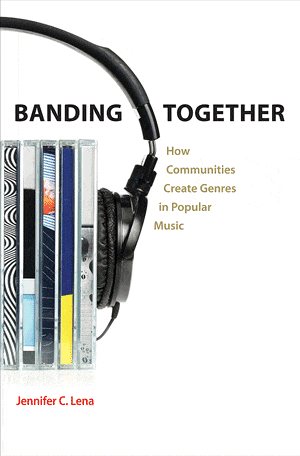by Keidra Chaney

“Music is particularly in need of thick histories,“ Lena writes in Chapter 1 of the book. “By attributing credit for bold innovations to single individuals, we have a fragile, thin explanation for the very complex worlds in which these performers lived.” Music journalism can be especially enamored with the “singular creative voice” narrative, when it comes to covering musicians, bands and songwriters. This narrative lends itself to interesting storytelling, of course, but it’s also a much less messy and complicated story than attempting to document the major players of a local or national musical community. The contribution of industry professionals, promoters, and fans frequently gets lost in the story, sometimes because they’re indirect – not connected to the music itself, but the community’s promotion or growth. But these missing threads of the narrative are still interesting stuff, and there are definite commonalities between seemingly disparate music communities in terms of their evolution and overall cultural trajectory. The goal of Lena’s work in Banding Together is to articulate those commonalities.
Lena identifies four primary genres or forms of music – Avant-garde, Scene-based, Industry-based, and Traditionalist – not classified by musical style, but from a sociocultural theoretical approach that takes into account issues of identity, industry, location, and culture. While her research examines sixty-four total musical styles, she focuses much of the book’s analysis on three specific musical styles –bluegrass, bebop jazz, and “old school”/early rap. While a little confusing at first, Lena takes great pains to distinguish between the definition of “genre” and “style” in this case. A music style may move from one genre classification to the next throughout its lifespan, as it grows in popularity, mainstream acceptance, and musical viability. As a metal fan, I read the book and immediately recognized metal placement in Traditionalist genre category:
“Traditionalist genres emerge when committed players, fans, and genre supporting business people decry what they identify as the adulterating consequences of the commercial exploitation of the music in the Industry-based genre. They focus on purifying the music by eradicating the excesses of the Industry-based genre and reenacting a version of what the music was like in its Scene-based period”
Come on, if that’s not metal now I don’t know what is.
Lena’s initial work in this field focused on the hip-hop community and hip-hop heads/sociologists may find this book of particular interest; she focuses primarily on the nascent years of rap in the 70’s and 80’s and the intertwining of social/community expression and commercial influence that complicate hip-hop’s historical narrative.
The sociocultural theory of genre types presented in Banding Together is not presented as a singular trajectory for all musical styles. For example, Lena mentions that Nu-metal and Grunge styles remained industry and scene-based and never go through a Traditionalist stage. In fact, only 16 of the musical styles she studied go through a trajectory of all four genre types. Many musical styles and communities evolve into something else as they become absorbed into other styles or co-opted by corporate influences. Lena also studies four “Government-purposed” music styles in China, Chile, Nigeria, and Serbia, and how music communities play a role in these countries to further specific mindsets and values.
Banding Together, while a pretty short read at 170 pages, is very much a historical piece of scholarship. It’s not ethnographic or an oral history; no first-person interviews appear in the book. It’s also not a book about fan communities, interestingly enough, at a time where so many scholarly books of this kind focus on fan communities and behavior.
Summary: Highly recommended. For readers used to reading “Aca-fan” style academic writing, Banding Together may take some getting used to but the work is fascinating and certainly needed, and may be of particular interest for music critics and journalists.

